Yifu Qiu
Iterative Multilingual Spectral Attribute Erasure
Jun 12, 2025Abstract:Multilingual representations embed words with similar meanings to share a common semantic space across languages, creating opportunities to transfer debiasing effects between languages. However, existing methods for debiasing are unable to exploit this opportunity because they operate on individual languages. We present Iterative Multilingual Spectral Attribute Erasure (IMSAE), which identifies and mitigates joint bias subspaces across multiple languages through iterative SVD-based truncation. Evaluating IMSAE across eight languages and five demographic dimensions, we demonstrate its effectiveness in both standard and zero-shot settings, where target language data is unavailable, but linguistically similar languages can be used for debiasing. Our comprehensive experiments across diverse language models (BERT, LLaMA, Mistral) show that IMSAE outperforms traditional monolingual and cross-lingual approaches while maintaining model utility.
Bootstrapping World Models from Dynamics Models in Multimodal Foundation Models
Jun 06, 2025Abstract:To what extent do vision-and-language foundation models possess a realistic world model (observation $\times$ action $\rightarrow$ observation) and a dynamics model (observation $\times$ observation $\rightarrow$ action), when actions are expressed through language? While open-source foundation models struggle with both, we find that fine-tuning them to acquire a dynamics model through supervision is significantly easier than acquiring a world model. In turn, dynamics models can be used to bootstrap world models through two main strategies: 1) weakly supervised learning from synthetic data and 2) inference time verification. Firstly, the dynamics model can annotate actions for unlabelled pairs of video frame observations to expand the training data. We further propose a new objective, where image tokens in observation pairs are weighted by their importance, as predicted by a recognition model. Secondly, the dynamics models can assign rewards to multiple samples of the world model to score them, effectively guiding search at inference time. We evaluate the world models resulting from both strategies through the task of action-centric image editing on Aurora-Bench. Our best model achieves a performance competitive with state-of-the-art image editing models, improving on them by a margin of $15\%$ on real-world subsets according to GPT4o-as-judge, and achieving the best average human evaluation across all subsets of Aurora-Bench.
What Is That Talk About? A Video-to-Text Summarization Dataset for Scientific Presentations
Feb 12, 2025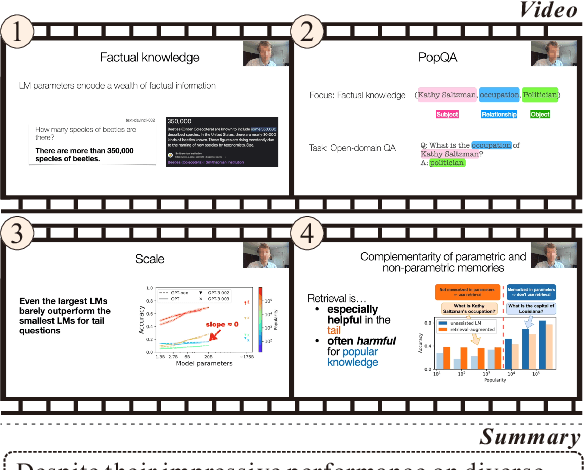
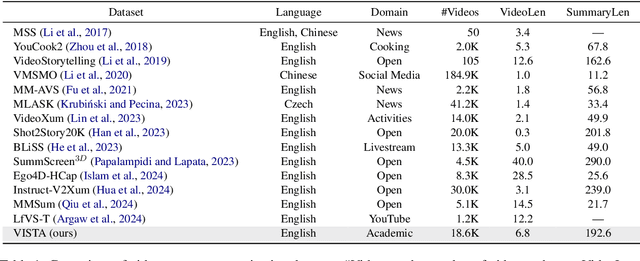
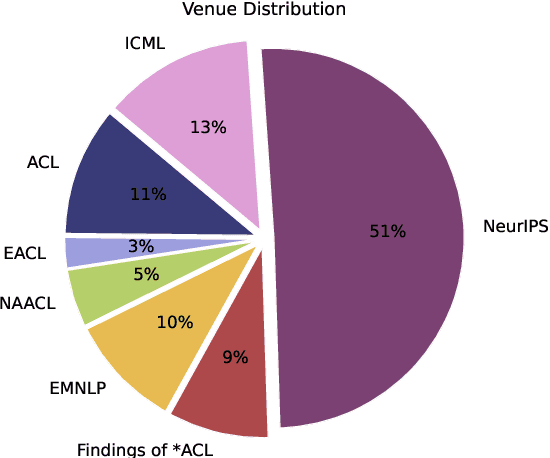
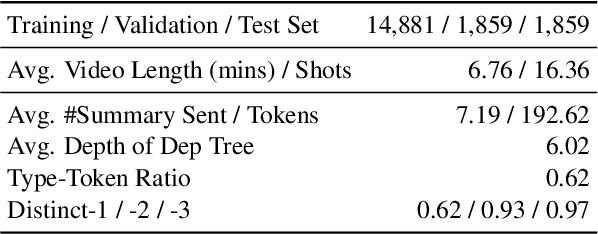
Abstract:Transforming recorded videos into concise and accurate textual summaries is a growing challenge in multimodal learning. This paper introduces VISTA, a dataset specifically designed for video-to-text summarization in scientific domains. VISTA contains 18,599 recorded AI conference presentations paired with their corresponding paper abstracts. We benchmark the performance of state-of-the-art large models and apply a plan-based framework to better capture the structured nature of abstracts. Both human and automated evaluations confirm that explicit planning enhances summary quality and factual consistency. However, a considerable gap remains between models and human performance, highlighting the challenges of scientific video summarization.
Multiple Instance Learning with Coarse-to-Fine Self-Distillation
Feb 04, 2025

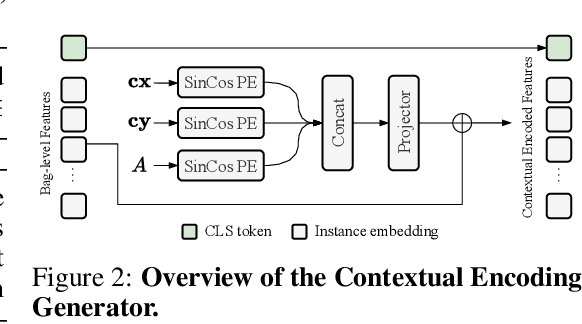

Abstract:Multiple Instance Learning (MIL) for whole slide image (WSI) analysis in computational pathology often neglects instance-level learning as supervision is typically provided only at the bag level. In this work, we present PathMIL, a framework designed to improve MIL through two perspectives: (1) employing instance-level supervision and (2) learning inter-instance contextual information on bag level. Firstly, we propose a novel Coarse-to-Fine Self-Distillation (CFSD) paradigm, to probe and distil a classifier trained with bag-level information to obtain instance-level labels which could effectively provide the supervision for the same classifier in a finer way. Secondly, to capture inter-instance contextual information in WSI, we propose Two-Dimensional Positional Encoding (2DPE), which encodes the spatial appearance of instances within a bag. We also theoretically and empirically prove the instance-level learnability of CFSD. PathMIL is evaluated on multiple benchmarking tasks, including subtype classification (TCGA-NSCLC), tumour classification (CAMELYON16), and an internal benchmark for breast cancer receptor status classification. Our method achieves state-of-the-art performance, with AUC scores of 0.9152 and 0.8524 for estrogen and progesterone receptor status classification, respectively, an AUC of 0.9618 for subtype classification, and 0.8634 for tumour classification, surpassing existing methods.
Eliciting In-context Retrieval and Reasoning for Long-context Large Language Models
Jan 14, 2025
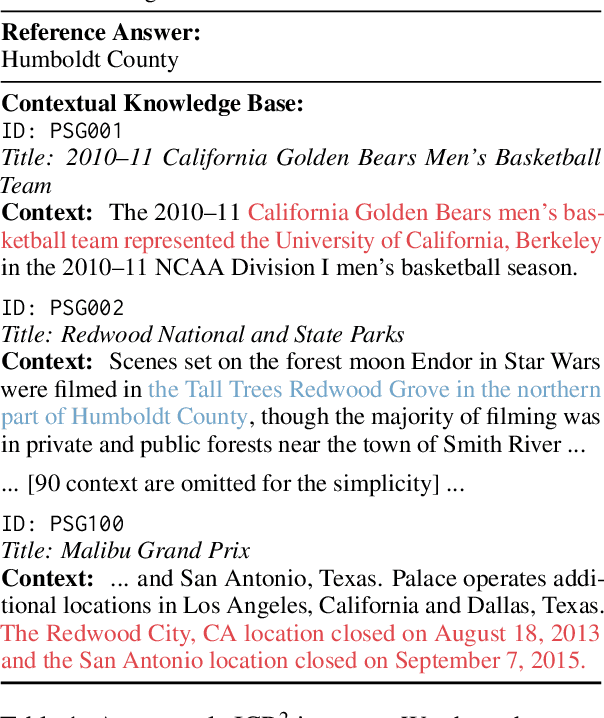
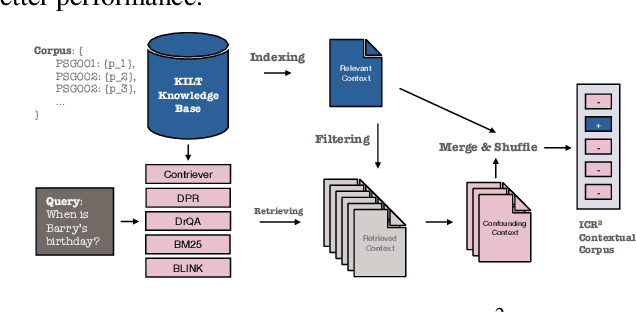
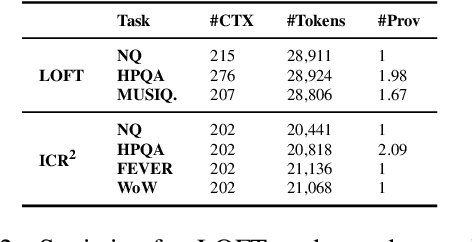
Abstract:Recent advancements in long-context language models (LCLMs) promise to transform Retrieval-Augmented Generation (RAG) by simplifying pipelines. With their expanded context windows, LCLMs can process entire knowledge bases and perform retrieval and reasoning directly -- a capability we define as In-Context Retrieval and Reasoning (ICR^2). However, existing benchmarks like LOFT often overestimate LCLM performance by providing overly simplified contexts. To address this, we introduce ICR^2, a benchmark that evaluates LCLMs in more realistic scenarios by including confounding passages retrieved with strong retrievers. We then propose three methods to enhance LCLM performance: (1) retrieve-then-generate fine-tuning, (2) retrieval-attention-probing, which uses attention heads to filter and de-noise long contexts during decoding, and (3) joint retrieval head training alongside the generation head. Our evaluation of five well-known LCLMs on LOFT and ICR^2 demonstrates significant gains with our best approach applied to Mistral-7B: +17 and +15 points by Exact Match on LOFT, and +13 and +2 points on ICR^2, compared to vanilla RAG and supervised fine-tuning, respectively. It even outperforms GPT-4-Turbo on most tasks despite being a much smaller model.
Spectral Editing of Activations for Large Language Model Alignment
May 15, 2024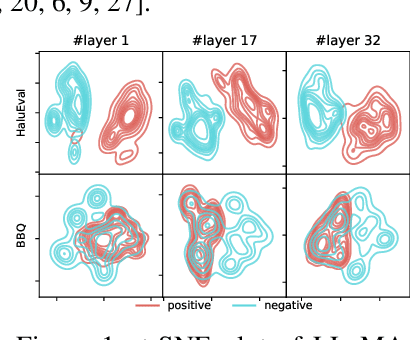
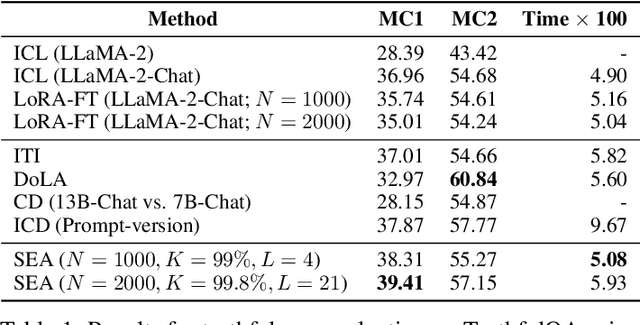

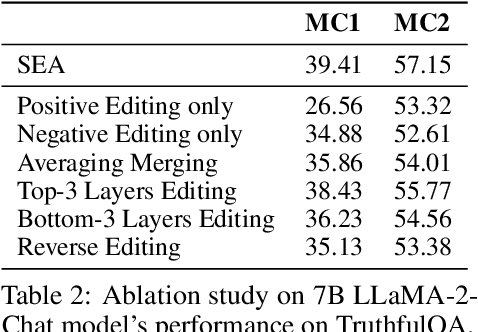
Abstract:Large language models (LLMs) often exhibit undesirable behaviours, such as generating untruthful or biased content. Editing their internal representations has been shown to be effective in mitigating such behaviours on top of the existing alignment methods. We propose a novel inference-time editing method, namely spectral editing of activations (SEA), to project the input representations into directions with maximal covariance with the positive demonstrations (e.g., truthful) while minimising covariance with the negative demonstrations (e.g., hallucinated). We also extend our method to non-linear editing using feature functions. We run extensive experiments on benchmarks concerning truthfulness and bias with six open-source LLMs of different sizes and model families. The results demonstrate the superiority of SEA in effectiveness, generalisation to similar tasks, as well as inference and data efficiency. We also show that SEA editing only has a limited negative impact on other model capabilities.
EEE-QA: Exploring Effective and Efficient Question-Answer Representations
Mar 04, 2024Abstract:Current approaches to question answering rely on pre-trained language models (PLMs) like RoBERTa. This work challenges the existing question-answer encoding convention and explores finer representations. We begin with testing various pooling methods compared to using the begin-of-sentence token as a question representation for better quality. Next, we explore opportunities to simultaneously embed all answer candidates with the question. This enables cross-reference between answer choices and improves inference throughput via reduced memory usage. Despite their simplicity and effectiveness, these methods have yet to be widely studied in current frameworks. We experiment with different PLMs, and with and without the integration of knowledge graphs. Results prove that the memory efficacy of the proposed techniques with little sacrifice in performance. Practically, our work enhances 38-100% throughput with 26-65% speedups on consumer-grade GPUs by allowing for considerably larger batch sizes. Our work sends a message to the community with promising directions in both representation quality and efficiency for the question-answering task in natural language processing.
Are Large Language Models Temporally Grounded?
Nov 16, 2023Abstract:Are Large language models (LLMs) temporally grounded? Since LLMs cannot perceive and interact with the environment, it is impossible to answer this question directly. Instead, we provide LLMs with textual narratives and probe them with respect to their common-sense knowledge of the structure and duration of events, their ability to order events along a timeline, and self-consistency within their temporal model (e.g., temporal relations such as after and before are mutually exclusive for any pair of events). We evaluate state-of-the-art LLMs (such as LLaMA 2 and GPT-4) on three tasks reflecting these abilities. Generally, we find that LLMs lag significantly behind both human performance as well as small-scale, specialised LMs. In-context learning, instruction tuning, and chain-of-thought prompting reduce this gap only to a limited degree. Crucially, LLMs struggle the most with self-consistency, displaying incoherent behaviour in at least 27.23% of their predictions. Contrary to expectations, we also find that scaling the model size does not guarantee positive gains in performance. To explain these results, we study the sources from which LLMs may gather temporal information: we find that sentence ordering in unlabelled texts, available during pre-training, is only weakly correlated with event ordering. Moreover, public instruction tuning mixtures contain few temporal tasks. Hence, we conclude that current LLMs lack a consistent temporal model of textual narratives. Code, datasets, and LLM outputs are available at https://github.com/yfqiu-nlp/temporal-llms.
Think While You Write: Hypothesis Verification Promotes Faithful Knowledge-to-Text Generation
Nov 16, 2023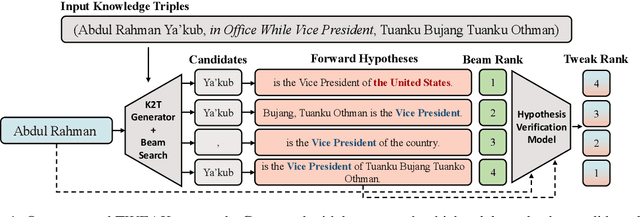
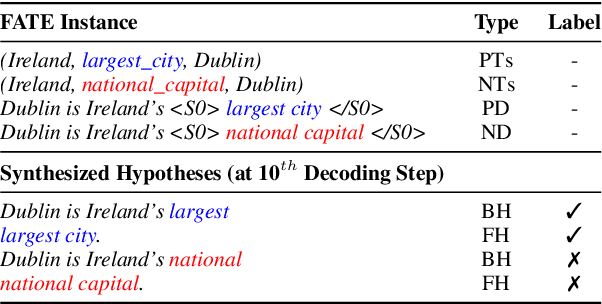
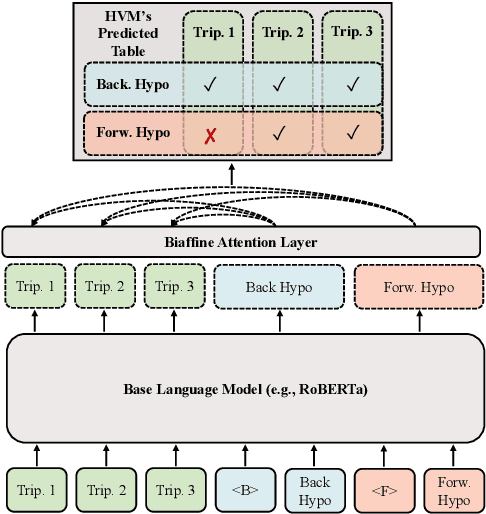
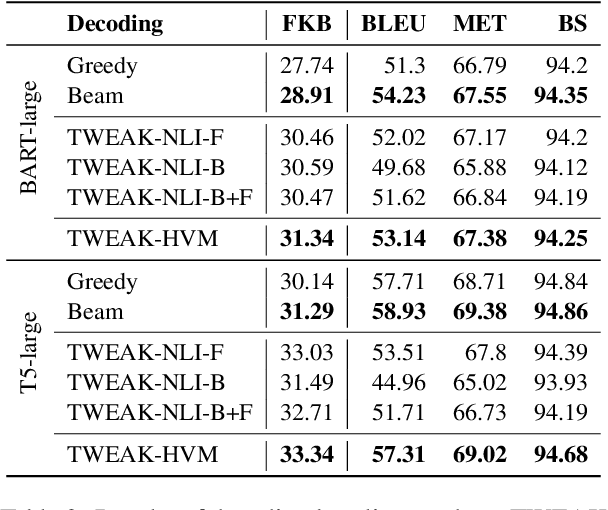
Abstract:Neural knowledge-to-text generation models often struggle to faithfully generate descriptions for the input facts: they may produce hallucinations that contradict the given facts, or describe facts not present in the input. To reduce hallucinations, we propose a novel decoding method, TWEAK (Think While Effectively Articulating Knowledge). TWEAK treats the generated sequences at each decoding step and its future sequences as hypotheses, and ranks each generation candidate based on how well their corresponding hypotheses support the input facts using a Hypothesis Verification Model (HVM). We first demonstrate the effectiveness of TWEAK by using a Natural Language Inference (NLI) model as the HVM and report improved faithfulness with minimal impact on the quality. We then replace the NLI model with our task-specific HVM trained with a first-of-a-kind dataset, FATE (Fact-Aligned Textual Entailment), which pairs input facts with their faithful and hallucinated descriptions with the hallucinated spans marked. The new HVM improves the faithfulness and the quality further and runs faster. Overall the best TWEAK variants improve on average 2.22/7.17 points on faithfulness measured by FactKB over WebNLG and TekGen/GenWiki, respectively, with only 0.14/0.32 points degradation on quality measured by BERTScore over the same datasets. Since TWEAK is a decoding-only approach, it can be integrated with any neural generative model without retraining.
Detecting and Mitigating Hallucinations in Multilingual Summarisation
May 23, 2023Abstract:Hallucinations pose a significant challenge to the reliability of neural models for abstractive summarisation. While automatically generated summaries may be fluent, they often lack faithfulness to the original document. This issue becomes even more pronounced in low-resource settings, such as cross-lingual transfer. With the existing faithful metrics focusing on English, even measuring the extent of this phenomenon in cross-lingual settings is hard. To address this, we first develop a novel metric, mFACT, evaluating the faithfulness of non-English summaries, leveraging translation-based transfer from multiple English faithfulness metrics. We then propose a simple but effective method to reduce hallucinations with a cross-lingual transfer, which weighs the loss of each training example by its faithfulness score. Through extensive experiments in multiple languages, we demonstrate that mFACT is the metric that is most suited to detect hallucinations. Moreover, we find that our proposed loss weighting method drastically increases both performance and faithfulness according to both automatic and human evaluation when compared to strong baselines for cross-lingual transfer such as MAD-X. Our code and dataset are available at https://github.com/yfqiu-nlp/mfact-summ.
 Add to Chrome
Add to Chrome Add to Firefox
Add to Firefox Add to Edge
Add to Edge